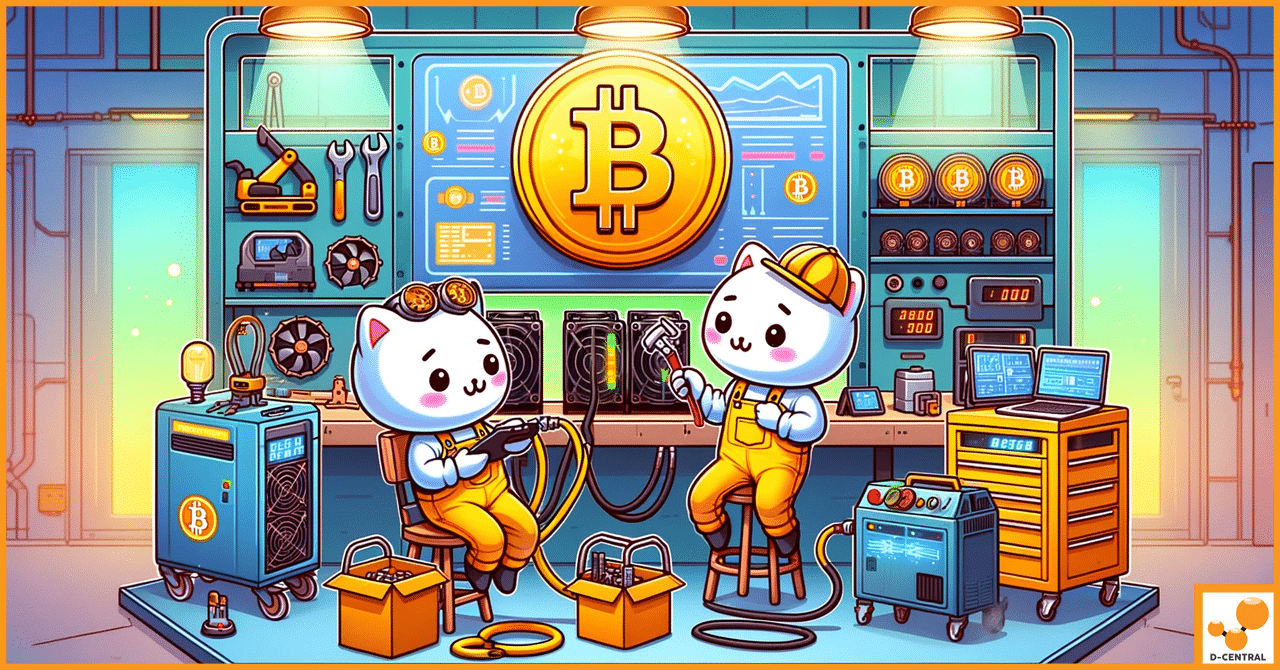
Why Bitcoin is the Aurodium of Our World
In the ever-evolving landscape of finance and technology, Bitcoin has emerged as a pivotal force, reshaping our understanding of value
4479 Desserte Nord Autoroute 440, Laval, QC H7P 6E2
A mining rig for mining is a specialized computer designed specifically for mining cryptocurrencies. This guide explains the key components, types of rigs, setup process, and maintenance tips to help you build an efficient mining system.
A mining rig is a customized computer designed specifically to solve cryptographic equations, which is the backbone of mining cryptocurrencies like Bitcoin. These machines, known as bitcoin mining rigs when used for Bitcoin, compete to solve complex cryptographic puzzles to confirm new blocks of transactions on the Bitcoin network. This process is vital for maintaining the security and decentralization of the Bitcoin network. Bitcoin mining rigs typically use the SHA-256 algorithm to solve cryptographic puzzles. Initially, personal computers were sufficient for mining due to low competition, but today’s landscape requires significantly more power.
Mining rigs have evolved from basic personal computers to highly specialized, energy-efficient systems. GPU mining rigs stand out due to their superior efficiency in solving cryptographic hashes problems.
While CPUs can still mine some altcoins, their role in Bitcoin mining has dwindled to near insignificance due to the astronomical difficulty. Today, the focus is on powerful machines capable of handling the ever-increasing complexity of mining algorithms.
To build a mining rig, you need to gather the essential components, which include a power supply unit that meets the energy demands of all components:
Each component significantly impacts the rig’s performance.
The GPUs are the heart of the mining rig, tasked with solving complex equations to validate blockchain transactions. Multiple high-performance GPUs are typically used to enhance efficiency and profitability. The more GPUs a rig has, the higher its hash rate will be, which measures how quickly it can solve equations. Alongside GPUs, a powerful CPU ensures smooth operation and supports the overall system. RAM and storage, preferably SSD, are also crucial for quick data retrieval and system performance.
Effective power management is crucial. The PSU must be capable of supporting the power needs of multiple GPUs and other components. The power requirements for a GPU mining rig can range from 800 to 1500 watts or more depending on the components used. Additionally, effective cooling systems prevent overheating and ensure hardware longevity. When chosen and assembled correctly, these components form the backbone of an efficient mining rig.
Mining rigs come in various forms, each tailored to different needs and efficiency levels. The three main types are CPU, GPU, and ASIC mining rigs.
CPU mining rigs, once sufficient in Bitcoin’s early days, have largely been surpassed by more powerful alternatives. GPU mining rigs use graphics processing units for enhanced computational power and versatility. A bitcoin mining rig is now often preferred for more gpus efficient mining.
ASIC mining rigs are specialized hardware designed for specific algorithms, offering the highest efficiency and hash rates but at a higher cost. Each type has its unique advantages and is suited for different mining scenarios.
In the nascent stages of Bitcoin, personal computers with their central processing units (CPUs) were adequate for mining, thanks to the low competition and mining difficulty. However, as Bitcoin mining’s popularity and complexity grew, CPU mining became impractical. Today’s mining landscape requires significantly more computational power than CPUs can provide.
Despite this, CPU mining rigs are still used for certain altcoins. They are still used for mining various altcoins with lower difficulty levels. These rigs are simpler to set up and more affordable, making them accessible for beginners or those mining other cryptocurrencies.
However, the potential returns are substantially lower compared to GPU and ASIC rigs due to less power hash rates and efficiency.
GPU mining rigs leverage the power of graphics processing units, which excel at handling the complex computations required for mining. GPUs are far more efficient than CPUs in solving cryptographic puzzles, making them ideal for mining various cryptocurrencies. The ability to process multiple computations simultaneously gives GPUs a distinct advantage in the competitive mining environment.
Using multiple GPUs enhances computational power and profitability in GPU mining by:
Several factors influence GPU mining profitability, including hash rate, power consumption, and the market price of the mined cryptocurrency. High-end GPUs offer better performance but have higher energy demands and costs. Balancing the number of GPUs, their performance, and overall power consumption is crucial for optimal profitability.
ASIC mining rigs are the pinnacle of mining hardware, designed for mining Bitcoin and other cryptocurrencies using specific algorithms. These rigs offer unparalleled efficiency and hash rates, making them the preferred choice for industrial-scale mining operations. The Bitmain Antminer S21e XP Hyd 3U delivers a hash rate of 860 TH/s with a power consumption of 11,180W, achieving energy efficiency at 13 j/Th. The Bitmain Antminer S21e XP Hyd 3U is an example of a highly profitable ASIC miner, showcasing the advanced capabilities of modern mining hardware.
ASIC miners’ efficiency comes at a cost, both in terms of initial investment and noise levels. However, their ability to solve Bitcoin’s SHA-256 puzzles quickly and efficiently makes them indispensable for serious miners. Investing in ASIC mining rigs can significantly increase profitability and operational efficiency for dedicated miners.
Selecting the right mining rig depends on budget, desired cryptocurrency, and long-term goals. A mining rig’s performance is measured by its hash rate, indicating how quickly it can solve cryptographic problems. ASIC miners, while costly, offer the highest hash rates and energy efficiency, making them ideal for those looking to mine Bitcoin at scale.
For beginners or those with limited budgets, GPU mining rigs are a versatile choice. They offer moderate costs, ease of access, and the ability to mine multiple cryptocurrencies. CPUs, though less efficient, can still be a starting point for mining altcoins with lower difficulty levels. However, the profitability of these rigs is highly influenced by fluctuating cryptocurrency prices, electricity costs, and market conditions.
Consider the following factors when choosing a mining rig:
For advanced users, models like the Antminer S21 offer exceptional performance and speed efficiency.
Carefully selecting components is necessary for setting up a mining rig. These include GPUs, a motherboard, CPU, RAM, a power supply unit, and storage, all of which must be properly assembled. First, assemble the mining rig frame, ensuring all screws are properly tightened for stability. Handle the CPU with care when installing the mainboard to avoid bending pins, and apply thermal paste correctly for proper heat dissipation.
Once the hardware is in place, follow these steps:
After assembling the hardware, follow these steps:
Cryptocurrency mining is power-intensive, with Bitcoin mining alone accounting for around 0.6% of the world’s total electricity usage. High energy demands necessitate using energy-efficient hardware to lower electricity expenses and enhance profitability. Bitcoin mining machines are expensive pieces of equipment, and you should research energy costs where you live before investing. Investing in energy-efficient components and exploring cost-effective power sources optimizes crypto mining efficiency, raising the question of how much power is required for optimal results.
Mining during off-peak electricity hours can further reduce operational costs and lower electricity costs. Monitoring your mining rig’s power consumption and making efficiency adjustments is crucial. Optimizing energy use helps miners achieve better returns and contributes to more sustainable mining operations.
Effective cooling solutions prevent overheating and ensure optimal mining rig performance. Air cooling, the most common method, uses fans to circulate air and remove heat. Cost-effective and easier to maintain, it is a popular choice for miners. Air cooling setups can be designed in negative or positive pressure configurations, each with its own benefits and drawbacks.
For larger operations, water cooling systems offer a scalable solution by absorbing heat directly from components. Immersion cooling, submerging hardware in a thermally conductive liquid, significantly enhances heat dissipation and reduces dust accumulation, potentially prolonging equipment lifespan. Hydro cooling systems can effectively regulate temperatures, supporting higher operational speeds without overheating.
Key practices for maintaining hardware include:
Mining pools are collaborative networks where miners combine computational power to increase their chances of mining new blocks. Individual miners join mining pools for consistent Bitcoin rewards, as combined computational power increases the likelihood of solving cryptographic puzzles. This collaboration provides more reliable income streams than solo mining, as rewards are distributed based on contributed hashpower.
Joining a mining pool lowers the entry barriers for new miners, allowing participation without significant hardware investments. Mining pools help maintain network security by distributing mining power among participants.
Many mining pools operate under various reward systems to ensure pay, making them essential to the mining ecosystem.
Maximizing profitability requires:
Several factors affect GPU mining profitability. These include:
Regular maintenance ensures optimal performance. This includes:
If overheating recurs, upgrading to liquid cooling may help. For unresolved issues, professional repair services may be necessary.
Following these tips ensures efficient operation and minimizes downtime.
The mining hardware landscape is evolving, with innovations enhancing energy efficiency and computational power. Using more efficient equipment can lead to significant energy savings and increased output. D-Central Technologies, for instance, manufactures advanced mining hardware like the Bitaxe series, which utilizes one or multiple BM1368 and BM1370 chips for optimal efficiency.
D-Central Technologies also emphasizes Canada manufacturing and local 3D printing, contributing to the development of innovative products like the Antminer Slim and Loki Editions, which double as Bitcoin space heaters. These advancements not only improve mining performance but also offer unique solutions like dual-purpose mining equipment, showcasing the world’s continuous progress in mining hardware technology.
In summary, choosing the right mining rig, setting it up correctly, and maintaining it efficiently are crucial steps for successful bitcoin mining. From understanding the basics to exploring advanced innovations, this guide provides the knowledge needed to navigate the complex world of crypto mining. As the industry evolves, staying informed and adapting to new technologies will be key to maximizing profitability and achieving mining success.
A mining rig is a specialized computer built for the purpose of mining cryptocurrencies by solving complex cryptographic problems. These rigs can range from standard personal computers to advanced, energy-efficient setups.
The main types of mining rigs are CPU, GPU, and ASIC mining rigs, each offering varying levels of efficiency tailored to specific mining needs. Understanding these differences can help you choose the right rig for your requirements.
To choose the right mining rig, consider your budget, the type of cryptocurrency you plan to mine, and energy efficiency. ASIC miners provide higher hash rates but at a higher cost, while GPU rigs are more versatile and better for beginners.
Cooling is essential for mining rigs to prevent overheating, ensuring optimal performance and reducing the risk of equipment failures. Implementing effective cooling solutions, such as air, water, or immersion cooling, is key to maintaining operational efficiency.
Mining pools are essential because they allow miners to combine their computational power, enhancing their chances of successfully mining blocks and ensuring a more stable income while contributing to network security. Many miners join mining pools to combine hash power and split rewards, increasing their odds of earning consistent cryptocurrency rewards.
DISCLAIMER: D-Central Technologies and its associated content, including this blog, do not serve as financial advisors or official investment advisors. The insights and opinions shared here or by any guests featured in our content are provided purely for informational and educational purposes. Such communications should not be interpreted as financial, investment, legal, tax, or any form of specific advice. We are committed to advancing the knowledge and understanding of Bitcoin and its potential impact on society. However, we urge our community to proceed with caution and informed judgment in all related endeavors.
Related Posts

In the ever-evolving landscape of finance and technology, Bitcoin has emerged as a pivotal force, reshaping our understanding of value

Welcome to the fascinating world where the realms of gaming and cryptocurrency converge. At the forefront of this innovative crossroads

In the rapidly evolving landscape of the Bitcoin mining industry, Application-Specific Integrated Circuits (ASICs) have emerged as the cornerstone of